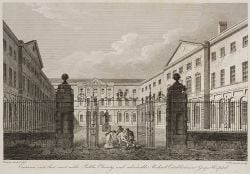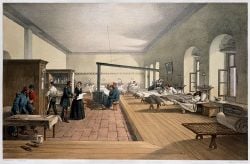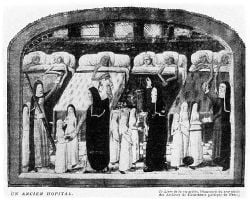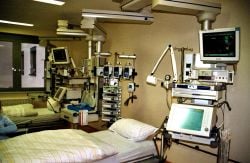Hospital

A hospital is a health care institution providing patient treatment with specialized medical and nursing staff and equipment. The best-known type of hospital is the general hospital, which typically has an emergency department to treat urgent health problems ranging from accident victims to a sudden illness. A district hospital typically is the major health care facility in its region, with many beds for intensive care and additional beds for patients who need long-term care. Specialized hospitals include trauma centers, rehabilitation hospitals, children's hospitals, seniors' (geriatric) hospitals, and hospitals for dealing with specific medical needs such as psychiatric treatment and certain disease categories.
In accordance with the original meaning of the word, hospitals were originally "places of hospitality," and were often run by religious orders. As medicine developed, the focus of the hospital moved from a place of respite for the unfortunate, to caring for the sick and injured, and finally to curing disease and healing victims of trauma. Many larger hospitals also provided support to the development of medical science. Today, hospitals are staffed by trained professionals who have at their disposal medicines and technology to treat even the most difficult cases. While no longer run by charitable organizations, hospitals continue to be places for healing and care for those members of society who are in need.
Etymology

The word "hospital" comes from the Latin hospes, signifying a stranger or foreigner, hence a guest. Another noun derived from this, hospitium came to signify hospitality, that is the relation between guest and shelterer, hospitality, friendliness, and hospitable reception. By metonymy the Latin word then came to mean a guest-chamber, guest's lodging, an inn.[1]
Hospes is thus the root for the English words host (where the p was dropped for convenience of pronunciation) hospitality, hospice, hostel and hotel. The latter modern word derives from Latin via the ancient French romance word hostel, which developed a silent s, which letter was eventually removed from the word, the loss of which is signified by a circumflex in the modern French word hôtel. The German word 'Spital' shares similar roots.
In accordance with the original meaning of the word, hospitals were originally "places of hospitality," and this meaning is still preserved in the names of some institutions such as the Royal Hospital Chelsea, established in 1681 as a retirement and nursing home for veteran soldiers.
History
The history of hospitals has stretched over 2500 years, starting with precursors in the Ascelpian temples in ancient Greece and then the military hospitals in ancient Rome. Towards the end of the fourth century, the "second medical revolution" took place with the founding of the first Christian hospital in the eastern Byzantine Empire by Basil of Caesarea, and within a few decades, such hospitals had become ubiquitous in Byzantine society.
During the Middle Ages, hospitals served as almshouses for the poor, hostels for pilgrims, or hospital schools. The hospital would undergo development and progress throughout Byzantine, medieval European and Islamic societies, until the early modern era where care and healing would transition primarily into a secular affair.
Early examples

The earliest documented institutions aiming to provide cures were ancient Egyptian temples. Ruins of ancient hospitals in Sri Lanka are still in existence in Anuradhapura at the foot of the mountain Mihintale, and at Madirigiriya.[2] In early India India, Fa Xian, a Chinese Buddhist monk who traveled across India c. 400 C.E., recorded examples of healing institutions.[3] A hospital and medical training center also existed at Gundeshapur, a major city in southwest of the Sassanid Persian Empire founded in 271 C.E. by Shapur I.[4] In ancient Greece, temples known as Asclepeion, dedicated to the healer-god Asclepius, functioned as centers of medical advice, prognosis, and healing.[5] While public healthcare was non-existent in the Roman Empire, military hospitals called valetudinaria did exist stationed in military barracks and would serve the soldiers and slaves within the fort.[6] Evidence exists that some civilian hospitals, while unavailable to the Roman population, were occasionally privately built in extremely wealthy Roman households located in the countryside for that family, although this practice seems to have ended in 80 C.E.[5]
Medieval Islamic world
Medical knowledge was transmitted into the Islamic world through the Byzantine empire.[6] The earliest general hospital was built in 805 in Baghdad. By the tenth century, Baghdad had five more hospitals; Damascus had six hospitals by the fifteenth century; and Córdoba alone had 50 major hospitals, many exclusively for the military.[7] The Islamic hospital was an elaborate institution with a wide range of functions. In Islam, there was a moral imperative to treat the ill regardless of financial status. Islamic hospitals tended to be large, urban structures, and were largely secular institutions, many open to all, whether male or female, civilian or military, child or adult, rich or poor, Muslim or non-Muslim. The word Bimaristan referred to a hospital establishment where the ill were welcomed, cared for and treated by qualified staff. The Islamic hospital served several purposes, as a center of medical treatment, a home for patients recovering from illness or accidents, an insane asylum, and a retirement home with basic maintenance needs for the aged and infirm.[8]
Hospitals were forbidden by law to turn away patients who were unable to pay.[9] Eventually, charitable foundations called waqfs were formed to support hospitals, as well as schools.[9] Part of the state budget also went towards maintaining hospitals.[7]
Christianity, Late Antiquity, and Medieval Europe
Historically, hospitals were often founded and funded by religious orders, or by charitable individuals and leaders:
Although physicians were available in varying capacities in ancient Rome and Athens, the institution of a hospital dedicated to the care of the sick was a distinctly Christian innovation rooted in the monastic virtue and practise of hospitality. Arranged around the monastery were concentric rings of buildings in which the life and work of the monastic community was ordered. The outer ring of buildings served as a hostel in which travellers were received and boarded. The inner ring served as a place where the monastic community could care for the sick, the poor and the infirm. Monks were frequently familiar with the medicine available at that time, growing medicinal plants on the monastery grounds and applying remedies as indicated. As such, many of the practicing physicians of the Middle Ages were also clergy.[10]
The declaration of Christianity as an accepted religion in the Roman Empire drove an expansion of the provision of care. Following the First Council of Nicaea in 325 C.E., construction of a hospital in every cathedral town was begun, including among the earliest hospitals by Saint Sampson in Constantinople and by Basil, bishop of Caesarea in modern-day Turkey. By the twelfth century, Constantinople had two well-organized hospitals, staffed by doctors who were both male and female. Facilities included systematic treatment procedures and specialized wards for various diseases.

Early modern and Enlightenment period
The Hospital San Nicolás de Bari was constructed in 1503, in Santo Domingo, Dominican Republic, at the behest of governor (and namesake of the hospital) Nicolás de Ovando. Since the hospital began operating in 1522, it provided its services until the mid-eighteenth century. Today a preserved ruin, it is recognized by UNESCO for being the oldest hospital built in the Americas.[11]
In Europe the medieval concept of Christian care evolved during the sixteenth and seventeenth centuries into a secular one. In England, after the dissolution of the monasteries in 1540 by King Henry VIII, the church abruptly ceased to be the supporter of hospitals, and only by direct petition from the citizens of London, were the hospitals St Bartholomew's, St Thomas's, and St Mary of Bethlehem's (Bedlam) endowed directly by the crown; this was the first instance of secular support being provided for medical institutions.

The voluntary hospital movement began in the early eighteenth century, with hospitals being founded in London by the 1720s, including Westminster Hospital (1719) promoted by the private bank C. Hoare & Co and Guy's Hospital (1724) funded from the bequest of the wealthy merchant, Thomas Guy.
Other hospitals sprang up in London and other British cities over the century, many paid for by private subscriptions. These hospitals represented a turning point in the function of the institution; they began to evolve from being basic places of care for the sick to becoming centers of medical innovation and discovery and the principal place for the education and training of prospective practitioners. Some of the era's greatest surgeons and doctors worked and passed on their knowledge at the hospitals.[12] They also changed from being mere homes of refuge to being complex institutions for the provision of medicine and care for sick.
In 1710, the Charité was founded in Berlin by King Frederick I of Prussia as a response to an outbreak of plague. When the Vienna General Hospital opened in 1784 (instantly becoming the world's largest hospital), physicians acquired a new facility that gradually developed into one of the most important research centers.[13]
The concept of voluntary hospitals also spread to Colonial America: The Bellevue Hospital opened in 1736 (as a workhouse, then later becoming a hospital); the Pennsylvania Hospital opened in 1752,[14] New York Hospital in 1771, and Massachusetts General Hospital in 1811.
Another Enlightenment era charitable innovation was the dispensary; these would issue the poor with medicines free of charge. The London Dispensary opened its doors in 1696 as the first such clinic in the British Empire. The idea was slow to catch on until the 1770s,[15] when many such organizations began to appear, including the Public Dispensary of Edinburgh (1776), the Metropolitan Dispensary and Charitable Fund (1779) and the Finsbury Dispensary (1780). Dispensaries were also opened in New York 1771, Philadelphia 1786, and Boston 1796.[16]
Nineteenth century

In the mid-nineteenth century, hospitals and the medical profession became more professionalized, with a reorganization of hospital management along more bureaucratic and administrative lines. The Apothecaries Act 1815 made it compulsory for medical students to practice for at least half a year at a hospital as part of their training.[17]
Florence Nightingale pioneered the modern profession of nursing during the Crimean War when she set an example of compassion, commitment to patient care, and diligent and thoughtful hospital administration. The first official nurses' training program, the Nightingale School for Nurses within King's College London, was opened in 1860, with the mission of training nurses to work in hospitals, to work with the poor and to teach.[18] Nightingale was instrumental in reforming the nature of the hospital, by improving sanitation standards and changing the image of the hospital from a place the sick would go to die, to an institution devoted to recuperation and healing. She also emphasized the importance of statistical measurement for determining the success rate of a given intervention and pushed for administrative reform at hospitals.[19]
By the late nineteenth century, the modern hospital was beginning to take shape, with a proliferation of a variety of public and private hospital systems. By the 1870s, hospitals had more than trebled their original average intake of 3,000 patients. In continental Europe the new hospitals generally were built and run from public funds. During the nineteenth century, the Second Viennese Medical School emerged with the contributions of physicians such as Carl Freiherr von Rokitansky, Josef Škoda, Ferdinand Ritter von Hebra, and Ignaz Philipp Semmelweis. Basic medical science expanded and specialization advanced. Furthermore, the first dermatology, eye, as well as ear, nose, and throat clinics in the world were founded in Vienna, considered the birth of specialized medicine.[20]
Twentieth century and beyond
By the late nineteenth and the beginning twentieth century, medical advancements such as anesthesia and sterile techniques that could make surgery less risky, and availability of more advanced diagnostic devices such as X-rays, continued to make hospitals a more attractive option for treatment.
Microhospitals, which range from eight beds to fifty, were developed in the United States. Similarly, freestanding emergency rooms, which can handle emergencies and possibly transfer patients to hospitals, also began to become popular.
Hospitals are in part defined by their ability to admit patients into inpatient care. Some patients go to a hospital just for diagnosis, treatment, or therapy, and then leave ("outpatients") without staying overnight; while others are "admitted" and stay overnight or for several days or weeks or months ("inpatients"). Hospitals usually are distinguished from other types of medical facilities by their ability to admit and care for inpatients while other, smaller facilities are often described as clinics.
Modern hospitals measure various efficiency metrics such as occupancy rates, average length of stay, time to service, patient satisfaction, physician performance, patient readmission rate, inpatient mortality rate, and case mix index.
Types
Hospitals now take many different forms. They have a range of departments (such as surgery and urgent care) and specialist units such as cardiology. Some hospitals have outpatient departments and some have chronic treatment units. Common support units include a pharmacy, pathology, and radiology. A teaching hospital combines assistance to people with teaching to medical students and nurses. A smaller medical facility is generally called a clinic.

General and acute care
The best-known type of hospital is the general hospital, also known as an acute-care hospital. These facilities handle many kinds of disease and injury, and normally have an emergency department (sometimes known as "accident & emergency") or trauma center to deal with immediate and urgent threats to health. Larger cities may have several hospitals of varying sizes and facilities. Some hospitals have their own ambulance service.
District
A district hospital typically is the major health care facility in its region, with large numbers of beds for intensive care, critical care, and long-term care.
Specialized

Types of specialized hospitals include rehabilitation hospitals, children's hospitals, seniors' (geriatric) hospitals, long-term acute care facilities, and hospitals for dealing with specific medical needs such as psychiatric problems, certain disease categories such as cardiac, oncology, or orthopedic problems, and so forth.
A hospital may be a single building or a number of buildings on a campus. Many hospitals with pre-twentieth-century origins began as one building and evolved into campuses. Some hospitals are affiliated with universities for medical research and the training of medical personnel, such as physicians and nurses, ans are often called teaching hospitals. Worldwide, most hospitals are run on a nonprofit basis by governments or charities.
Teaching
A teaching hospital combines assistance to people with teaching to medical students and nurses and often is linked to a medical school, nursing school or university.
Clinics
The medical facility smaller than a hospital is generally called a clinic, and often is run by a government agency for health services or a private partnership of physicians (in nations where private practice is allowed). Clinics generally provide only outpatient services.
Departments or wards
Today, hospitals are staffed by professional physicians, surgeons, nurses, and allied health practitioners, whereas in the past, this work was usually performed by the members of founding religious orders or by volunteers. There are various Catholic religious orders, such as the Alexians and the Bon Secours Sisters, that continue to focus on hospital ministry, as well as several other Christian denominations, including the Methodists and Lutherans, which run hospitals.[21]
Hospitals consist of departments, traditionally called "wards," especially when they have beds for inpatients. Hospitals may have acute services such as an emergency department or specialist trauma center, burn unit, surgery, or urgent care. These may then be backed up by more specialist units such as the following:
- Cardiology
- Intensive care unit
- Pediatric intensive care unit
- Neonatal intensive care unit
- Cardiovascular intensive care unit
- Neurology
- Oncology
- Obstetrics and gynecology, colloquially, maternity ward
In addition, there is the department of nursing, often headed by a chief nursing officer or director of nursing. This department is responsible for the administration of professional nursing practice, research, and policy for the hospital. Nursing permeates every part of a hospital. Many units or wards have both a nursing and a medical director that serve as administrators for their respective disciplines within that specialty. For example, in an intensive care nursery, the director of neonatology is responsible for the medical staff and medical care while the nursing manager/director for the intensive care nursery is responsible for all of the nurses and nursing care in that unit/ward.
Some hospitals have outpatient departments and some have chronic treatment units such as behavioral health services, dentistry, dermatology, psychiatric ward, rehabilitation services, and physical therapy.
Common support units include a dispensary or pharmacy, pathology, and radiology. Hospitals also have a mortuary, where the dead are stored. On the non-medical side, there often are medical records departments, release of information departments, information management, clinical engineering, facilities management, plant operations, dining services, and security departments.
Buildings
Modern hospital buildings are designed to minimize the effort of medical personnel and the possibility of contamination while maximizing the efficiency of the whole system. Travel time for personnel within the hospital and the transportation of patients between units is facilitated and minimized. The building must accommodate heavy departments, such as radiology and operating rooms, while space for special wiring, plumbing, and waste disposal is included in the design.[22]
However, many hospitals, even those considered "modern," are the product of continual and often badly managed growth over decades or even centuries, with utilitarian new sections added on as needs and finances dictate.
Some newer hospitals now try to re-establish design that takes the patient's psychological needs into account, such as providing more fresh air, better views and more pleasant color schemes. These ideas hark back to the late eighteenth century, when the concept of providing fresh air and access to the 'healing powers of nature' were first employed by hospital architects in improving their buildings.
Good hospital design can reduce patient's recovery time. Exposure to daylight is effective in reducing depression. Single-sex accommodation help ensure that patients are treated in privacy and with dignity. Exposure to nature and hospital gardens is also important – looking out windows improves patients' moods and reduces blood pressure and stress level. Open windows in patient rooms have also demonstrated some evidence of beneficial outcomes by improving airflow and increased microbial diversity.[23] Eliminating long corridors can reduce nurses' fatigue and stress.
Another ongoing major development is the change from a ward-based system (where patients are accommodated in communal rooms, separated by movable partitions) to one in which they are accommodated in individual rooms. The ward-based system has been described as very efficient, especially for the medical staff, but is considered to be more stressful for patients and detrimental to their privacy. A major constraint on providing all patients with their own rooms is the higher cost of building and operating such a hospital.
Quality and safety
As the quality of health care has increasingly become an issue around the world, hospitals have increasingly had to pay serious attention to this matter. Independent external assessment of quality is one of the most powerful ways to assess this aspect of health care, and hospital accreditation is one means by which this is achieved. In many parts of the world such accreditation is sourced from other countries, a phenomenon known as international healthcare accreditation, by groups such as Accreditation Canada from Canada, the Joint Commission from the US, the Trent Accreditation Scheme from Great Britain, and Haute Autorité de Santé (HAS) from France.
Funding
Hospitals are usually funded by the public sector, health organizations (for profit or nonprofit), health insurance companies, or charities, including direct charitable donations. Modern hospitals are often funded by the government of the country in which they are situated.
In the United Kingdom for example, a relatively comprehensive, "free at the point of delivery" health care system exists, funded by the state. Hospital care is thus relatively easily available to all legal residents, although free emergency care is available to anyone, regardless of nationality or status. As hospitals prioritize their limited resources, there is a tendency for 'waiting lists' for non-crucial treatment in countries with such systems.
In some countries such as the US, hospitals typically operate privately and in some cases on a for-profit basis. Where for-profit hospitals in such countries admit uninsured patients in emergency situations, they incur direct financial losses, resulting in a clear disincentive to admit such patients. In the United States, laws exist to ensure patients receive care in life-threatening emergency situations regardless of the patient's ability to pay.[24]
Notes
- ↑ hospital Etymology Online. Retrieved April 23, 2020.
- ↑ W.I. Siriweera, Hospitals in ancient Sri Lanka Daily News, April 2, 2003. Retrieved April 23, 2020.
- ↑ James Legge, A Record of Buddhistic Kingdoms (Cosimo Classics, 2005, ISBN 978-1596055728).
- ↑ Mehmet Mahfuz Söylemez, [The Jundishapur School: Its History, Structure, and Functions https://www.academia.edu/14579207/The_Jundishapur_School_Its_History_Structure_and_Functions] The American Journal of Islamic Social Sciences 22:2. Retrieved April 23, 2020.
- ↑ 5.0 5.1 Guenter B. Risse, Mending Bodies, Saving Souls: A History of Hospitals (Oxford University Press, 1999, ISBN 978-0195055238).
- ↑ 6.0 6.1 Tiffany A. Ziegler, Medieval Healthcare and the Rise of Charitable Institutions (Palgrave Pivot, 2018, ISBN 978-3030020552).
- ↑ 7.0 7.1 David W. Tschanz, The Islamic Roots of the Modern Hospital AramcoWorld, March/April 2017. Retrieved April 23, 2020.
- ↑ Islamic Culture and the Medical Arts: Hospitals, United States National Library of Medicine. Retrieved April 23, 2020.
- ↑ 9.0 9.1 Susan Douglass (ed.), World Eras: Volume 2 Rise and Spread of Islam 622-1500 (Gale Research Inc., 2002, ISBN 978-0787645038).
- ↑ Daniel E. Hall, Altar and Table: A phenomenology of the surgeon-priest Yale Journal of Biology and Medicine 81(4) (December 2008): 193–198. Retrieved April 23, 2020.
- ↑ Colonial City of Santo Domingo UNESCO. Retrieved April 24, 2020.
- ↑ Harry Whitaker, C.U.M. Smith, and Stanley Finger (eds.), Brain, Mind and Medicine: Essays in Eighteenth-Century Neuroscience (Springer, 2007, ISBN 978-0387709666).
- ↑ Roderick E. McGrew, Encyclopedia of Medical History (McGraw-Hill, 1985. ISBN 978-0070450875).
- ↑ William Henry Williams, America's First Hospital: The Pennsylvania Hospital, 1751-1841 (Haverford House, 1976, ISBN 978-0910702027).
- ↑ Michael Whitfield, The Dispensaries: Healthcare for the Poor Before the NHS (Author House UK, 2016, ISBN 978-1504997164).
- ↑ Michael Marks Davis and Andrew Robert Warner, Dispensaries, Their Management and Development: A Book for Administrators, Public Health Workers, and All Interested in Better Medical Service for the People (Franklin Classics, 2018, ISBN 978-0342867431).
- ↑ Roy Porter, The Greatest Benefit to Mankind: A Medical History of Humanity from Antiquity to the Present (W.W. Norton & Company, 1999, ISBN 978-0393319804).
- ↑ The Nightingale Home and Training School for Nurses, St. Thomas's Hospital British Library. Retrieved April 24, 2020.
- ↑ Florence Nightingale, Measuring Hospital Care Outcomes (Joint Commission, 1999, ISBN 978-0866885591).
- ↑ Erna Lesky, The Vienna Medical School of the 19th Century (Johns Hopkins University Press, 1976, 978-0706513059).
- ↑ Odd S. Lovoll, The Promise Fulfilled: A Portrait of Norwegian Americans Today (University Of Minnesota Press, 2007, ISBN 978-0816628339).
- ↑ Annmarie Adams, Medicine by Design: The Architect and the Modern Hospital, 1893–1943 (University Of Minnesota Press, 2008, ISBN 978-0816651146).
- ↑ Neil Bowdler, Closing hospital windows 'increases infection risk' BBC, April 26, 2013. Retrieved April 24, 2020.
- ↑ Emergency Medical Treatment & Labor Act (EMTALA) Centers for Medicare & Medicaid Services. Retrieved April 24, 2020.
ReferencesISBN links support NWE through referral fees
- Adams, Annmarie. Medicine by Design: The Architect and the Modern Hospital, 1893–1943. University Of Minnesota Press, 2008. ISBN 978-0816651146
- Brockliss, Laurence, and Colin Jones. The Medical World of Early Modern France. Clarendon Press, 1997. ISBN 978-0198227502
- Davis, Michael Marks, and Andrew Robert Warner. Dispensaries, Their Management and Development: A Book for Administrators, Public Health Workers, and All Interested in Better Medical Service for the People. Franklin Classics, 2018. ISBN 978-0342867431
- Douglass, Susan (ed.). World Eras: Volume 2 Rise and Spread of Islam 622-1500. Gale Research Inc., 2002. ISBN 978-0787645038
- Granshaw, Lindsay, and Roy Porter (eds.). The Hospital in History. Routledge, 1989. ISBN 978-0415003759
- Harrison, Mark, Margaret Jones, and Helen Sweet (eds.). From Western Medicine to Global Medicine: The Hospital Beyond the West. Orient BlackSwan, 2009, ISBN 978-8125037026
- Horden, Peregrine. Hospitals and Healing From Antiquity to the Later Middle Ages. Routledge, 2008. ISBN 978-0754661818
- Legge, James. A Record of Buddhistic Kingdoms. Cosimo Classics, 2005. ISBN 978-1596055728
- Lesky, Erna. The Vienna Medical School of the 19th Century. Johns Hopkins University Press, 1976. ISBN 978-0706513059
- Lovoll, Odd S. The Promise Fulfilled: A Portrait of Norwegian Americans Today. University Of Minnesota Press, 2007. ISBN 978-0816628339
- McGrew, Roderick E. Encyclopedia of Medical History. McGraw-Hill, 1985. ISBN 978-0070450875
- Nightingale, Florence. Measuring Hospital Care Outcomes. Joint Commission, 1999. ISBN 978-0866885591
- Porter, Roy. The Greatest Benefit to Mankind: A Medical History of Humanity from Antiquity to the Present. W.W. Norton & Company, 1999. ISBN 978-0393319804
- Risse, Guenter B. Mending Bodies, Saving Souls: A History of Hospitals. Oxford University Press, 1999. ISBN 978-0195055238
- Rosenberg, Charles E. The Care of Strangers: The Rise of America's Hospital System. The Johns Hopkins University Press, 1995. ISBN 978-0801850820
- Wall, Barbra Mann. American Catholic Hospitals: A Century of Changing Markets and Missions. Rutgers University Press, 2016. ISBN 978-0813576442
- Whitaker, Harry. C.U.M. Smith, and Stanley Finger (eds.). Brain, Mind and Medicine: Essays in Eighteenth-Century Neuroscience. Springer, 2007. ISBN 978-0387709666
- Whitfield, Michael. The Dispensaries: Healthcare for the Poor Before the NHS. Author House UK, 2016. ISBN 978-1504997164
- Williams, William Henry. America's First Hospital: The Pennsylvania Hospital, 1751-1841. Haverford House, 1976. ISBN 978-0910702027
- Ziegler, Tiffany A. Medieval Healthcare and the Rise of Charitable Institutions. Palgrave Pivot, 2018. ISBN 978-3030020552
External links
All links retrieved July 19, 2024.
- Hospitals World Health Organization
| |||||||||||||||||
| Health science – Medicine |
|---|
| Anesthesiology | Dermatology | Emergency Medicine | General practice | Internal medicine | Neurology | Obstetrics & Gynaecology | Occupational Medicine | Pathology | Pediatrics | Physical Medicine & Rehabilitation | Podiatry | Psychiatry | Public Health | Radiology | Surgery |
| Branches of Internal medicine |
| Cardiology | Endocrinology | Gastroenterology | Hematology | Infectious diseases | Intensive care medicine | Nephrology | Oncology | Pulmonology | Rheumatology |
| Branches of Surgery |
| Cardiothoracic surgery | Dermatologic surgery | General surgery | Gynecological surgery | Neurosurgery | Ophthalmic surgery | Oral and maxillofacial surgery | Organ Transplantation | Orthopedic surgery | Otolaryngology (ENT) | Pediatric surgery | Plastic surgery | Podiatric surgery | Surgical oncology | Trauma surgery | Urology | Vascular surgery |
Credits
New World Encyclopedia writers and editors rewrote and completed the Wikipedia article in accordance with New World Encyclopedia standards. This article abides by terms of the Creative Commons CC-by-sa 3.0 License (CC-by-sa), which may be used and disseminated with proper attribution. Credit is due under the terms of this license that can reference both the New World Encyclopedia contributors and the selfless volunteer contributors of the Wikimedia Foundation. To cite this article click here for a list of acceptable citing formats.The history of earlier contributions by wikipedians is accessible to researchers here:
The history of this article since it was imported to New World Encyclopedia:
Note: Some restrictions may apply to use of individual images which are separately licensed.









